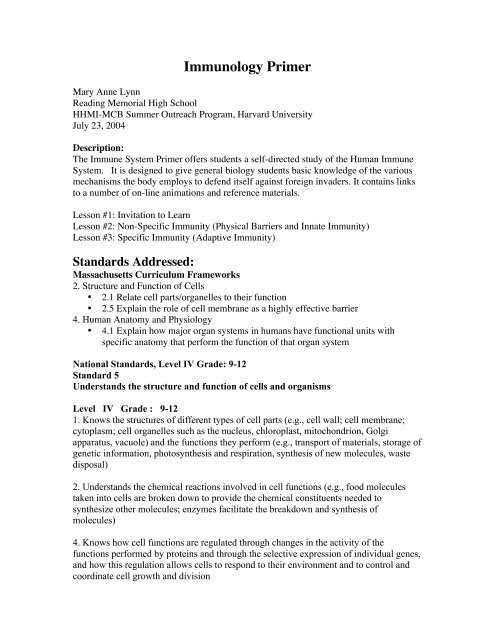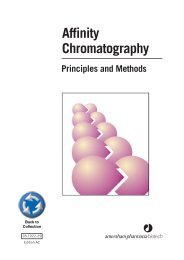Immunology Primer - Life Sciences Outreach Program - Harvard ...
Immunology Primer - Life Sciences Outreach Program - Harvard ...
Immunology Primer - Life Sciences Outreach Program - Harvard ...
You also want an ePaper? Increase the reach of your titles
YUMPU automatically turns print PDFs into web optimized ePapers that Google loves.
<strong>Immunology</strong> <strong>Primer</strong><br />
Mary Anne Lynn<br />
Reading Memorial High School<br />
HHMI-MCB Summer <strong>Outreach</strong> <strong>Program</strong>, <strong>Harvard</strong> University<br />
July 23, 2004<br />
Description:<br />
The Immune System <strong>Primer</strong> offers students a self-directed study of the Human Immune<br />
System. It is designed to give general biology students basic knowledge of the various<br />
mechanisms the body employs to defend itself against foreign invaders. It contains links<br />
to a number of on-line animations and reference materials.<br />
Lesson #1: Invitation to Learn<br />
Lesson #2: Non-Specific Immunity (Physical Barriers and Innate Immunity)<br />
Lesson #3: Specific Immunity (Adaptive Immunity)<br />
Standards Addressed:<br />
Massachusetts Curriculum Frameworks<br />
2. Structure and Function of Cells<br />
• 2.1 Relate cell parts/organelles to their function<br />
• 2.5 Explain the role of cell membrane as a highly effective barrier<br />
4. Human Anatomy and Physiology<br />
• 4.1 Explain how major organ systems in humans have functional units with<br />
specific anatomy that perform the function of that organ system<br />
National Standards, Level IV Grade: 9-12<br />
Standard 5<br />
Understands the structure and function of cells and organisms<br />
Level IV Grade : 9-12<br />
1. Knows the structures of different types of cell parts (e.g., cell wall; cell membrane;<br />
cytoplasm; cell organelles such as the nucleus, chloroplast, mitochondrion, Golgi<br />
apparatus, vacuole) and the functions they perform (e.g., transport of materials, storage of<br />
genetic information, photosynthesis and respiration, synthesis of new molecules, waste<br />
disposal)<br />
2. Understands the chemical reactions involved in cell functions (e.g., food molecules<br />
taken into cells are broken down to provide the chemical constituents needed to<br />
synthesize other molecules; enzymes facilitate the breakdown and synthesis of<br />
molecules)<br />
4. Knows how cell functions are regulated through changes in the activity of the<br />
functions performed by proteins and through the selective expression of individual genes,<br />
and how this regulation allows cells to respond to their environment and to control and<br />
coordinate cell growth and division
6. Understands the processes of cell division and differentiation (e.g., meiosis, mitosis,<br />
embryo formation, cellular replication and differentiation into the many specialized cells,<br />
tissues, and organs that comprise the final organism; each cell retains the basic<br />
information needed to reproduce itself.
Immune System <strong>Primer</strong><br />
Lesson#1:Invitation to Learn<br />
A. Current Events<br />
1. What virus made headlines in Boston this summer when workers at five area<br />
restaurants tested positive for the virus?<br />
a. SARS<br />
b. HIV<br />
c. Hepatitis A<br />
d. Tuberculosis<br />
Use the Fact Sheet to check your answer. The information from the fact sheet can be<br />
used to answer the questions below.<br />
2. How might restaurant workers transmit the virus to customers?<br />
3. Symptoms?<br />
4. Why does hepatitis A often go undetected in day care centers?<br />
5. What steps can you take to prevent infection?<br />
B. Fighting Infections<br />
6. Viruses are one type of foreign invader that can infect a human. Disease causing<br />
organisms are called pathogens. Click here to find other examples of pathogens<br />
and list them below.<br />
1. Viruses<br />
2.<br />
3.<br />
4.<br />
7. What organ system defends your body against pathogens?
Immune System <strong>Primer</strong><br />
Lesson #2: Non-Specific Immunity<br />
C. First Line of Defense: Physical Barriers<br />
Skin is one of your body’s best defenses against foreign invaders. It acts as a physical<br />
barrier that blocks foreign substances from entering the body. Wash your hands!<br />
8. What factor(s) might prevent the skin from keeping pathogens out of your body?<br />
9. How might a pathogen enter your body without having to pass through your skin?<br />
(Hint: Think of organ systems that are most commonly infected.)<br />
Skin works with many other substances to block the entry of pathogens. Explain the role<br />
of the following substances in preventing infection.<br />
10. Sweat<br />
11. Mucus (a.k.a. Snot!)<br />
12. Saliva<br />
D. Second Line of Defense: Innate Immunity<br />
13. Some pathogens are clever enough to get past your body’s first line of defense.<br />
Two of the cells sent to the site of infection to destroy foreign invaders are<br />
phagocytes and natural killer cells.<br />
1. Click on each cell type to watch a movie that demonstrates how each cell type<br />
works. One movie focuses on cytolytic T cells that work the same way as Natural<br />
Killer cells.<br />
2. Briefly describe how each cell works in the space provided.<br />
Phagocyte (Macrophages)<br />
big cell = macrophage<br />
small = pathogen<br />
Natural Killer Cell<br />
big cell = pathogen<br />
small cell = natural killer
Inflammatory Response shows how a body would react to a stab wound. To view the<br />
movie of the inflammatory response you must choose Inflammation Movie from the top<br />
of the list.<br />
14. What enters the body with a knife to generate an inflammatory response?<br />
15. What chemical is released from damaged cells?<br />
16. Blood cells diffuse into capillaries and cause the blood vessels to dilate. What<br />
does dilate mean?<br />
17. The four (4) symptoms of inflammation are:<br />
1.<br />
2.<br />
3.<br />
4.<br />
18. How might an increase in body temperature assist in fighting off infection?
Immune System <strong>Primer</strong><br />
Lesson #3: Specific Immunity<br />
E. Third Line of Defense: Adaptive Immunity<br />
Your body wages a war against pathogens that get past the first two lines of defense. It<br />
calls in its highly specialized warriors, the lymphocytes.<br />
Lymphocyte Development.<br />
Use the diagram to answer the following questions.<br />
19. All lymphocytes arise from stem<br />
cells in bone marrow or<br />
_______________ _______________.<br />
20. Lymphocyte stem cells that travel<br />
and develop in the _________________<br />
become “T” cells.<br />
21. Lymphocyte stem cells that remain<br />
in bone marrow develop into _____<br />
cells.<br />
Making Connections to prior knowledge:<br />
22. What process allows pluripotent stem cells to develop into different types of<br />
leucocytes?
Organs of the Immune System.<br />
Mature lymphocytes move to other lymphoid tissue.<br />
23. Identify three (3) areas of the body where lymph nodes<br />
are found.<br />
a.<br />
b.<br />
c.<br />
Diagram: http://www.niaid.nih.gov/final/immun/immun.htm<br />
Immune response.<br />
24. What is an antigen?<br />
To see how the human body elicits an Immune Response, click on the “Animation” file.<br />
Use the animation to answer the following questions.<br />
25. Briefly describe antigen processing.<br />
26. What types (2) of cells present antigen on their cell membranes?<br />
27. What type of cell is activated by antigen presentation?<br />
28. Compare and contrast Plasma and Memory cells. Be sure to state how they are<br />
similar and how they are different.<br />
29. What is the function of antibodies? How is their structure related to their function?
Making connections to previous knowledge.<br />
30. Why is important for B cells to contain numerous ribosomes? How is their structure<br />
related to their function?<br />
31. What chemicals enable lysosomes to breakdown the antigen?
Immune System <strong>Primer</strong><br />
Lesson #4: Primary and Secondary Immune Response.<br />
Primary And Secondary Immune Response<br />
http://academic.brooklyn.cuny.edu/biology/bio4fv/page/aviruses/helperTcells.html<br />
Interpreting the Graph:<br />
B cells are activated to release antibodies when cells of the body are infected with a<br />
pathogen. Use the graph and information below to answer the following questions.<br />
Focus on blue line.<br />
Primary immune response: body’s first exposure to an antigen.<br />
Secondary immune response: same pathogen is reintroduced to your body<br />
Independent variable (x axis): the length of time the body has been exposed to the antigen<br />
Dependent variable (y axis): concentration of antibodies in blood<br />
31. How many days does it take for B cells to start producing antibodies against<br />
antigen A during a primary immune response?<br />
32. On what day does antibody production peak during the primary immune response<br />
against antigen A?<br />
33. Compare antibody concentrations for antigen A during a primary and secondary<br />
immune response.<br />
View Fighting Back. It summarizes the Innate and Adaptive responses to pathogens.
References:<br />
“Boogers and Snot.” Thinkquest. Oracle Education Foundation.<br />
http://library.thinkquest.org/J0112390/Boogers.htm?tqskip1=1<br />
“Breaking a Sweat Produces Germ Fighter.” Preventdisease.com<br />
http://preventdisease.com/news/articles/breaking_sweat_produces_germ_fighter.shtml<br />
Campbell, Neil A., and Jane B. Reece. “The Body’s Defenses.” Biology. San Francisco,<br />
CA: Benjamin Cummings, 2002. 900-916.<br />
“Cellular Immune System: Origins”<br />
http://academic.brooklyn.cuny.edu/biology/bio4fv/page/aviruses/cellular-immune.html<br />
“Define: Antigen.” google.com<br />
‘Infection Dissection.” The Why Files. http://whyfiles.org/121emerg_infect/2.html<br />
“Inflammatory Response.” Univ. of Missouri Health Care.<br />
http://science.nhmccd.edu/biol/ap2int.htm#lymph.<br />
MA Department of Public Health. “Public Health Fact Sheet: Hepatitis A.”<br />
http://cbs4boston.com/siteSearch/local_story_168183458.html<br />
MA Science and Technology/Engineering Curriculum Framework Curriculum<br />
Frameworks<br />
www.doe.mass.edu/frameworks/scitech/2001/standards/ls9_101.html<br />
National Science Standards, 4 th edition. Mid-continent Research for Education and<br />
Learning. http://198.17.205.11/about/sitemap/sitemap.asp<br />
“Phagocytosis”. Cells Alive. http://www.cellsalive.com//mac.htm<br />
“Primary and Secondary Immune Response.”<br />
http://academic.brooklyn.cuny.edu/biology/bio4fv/page/aviruses/helperTcells.html<br />
Schittek, B., ... and C. Garbe. 2001. Dermcidin: A novel human antibiotic peptide<br />
secreted by sweat glands. Nature <strong>Immunology</strong> 2(December).<br />
“Saliva. “ Thinkquest. Oracle Education Foundation.<br />
http://library.thinkquest.org/2935/Natures_Best/Nat_Best_High_Level/Immune_Net_Pag<br />
es/Immune_page.html?tqskip1=1<br />
“Surviving AIDS: Fighting Back.” NOVA Online.<br />
http://www.pbs.org/wgbh/nova/aids/immunewave.html
“The Cytotoxic T Lymphocyte” Cells Alive. http://www.cellsalive.com/ctl.htm.<br />
“The Humoral Immune Response Tutorial.” <strong>Life</strong>: The Science of Biology, Sixth Edition.<br />
On-line. W.H. Freeman and Company.<br />
http://www.whfreeman.com/thelifewire6e/content/ch19/ch19xe04.htm<br />
“The Immune System.” NIAID Net News.<br />
http://www.niaid.nih.gov/final/immun/immun.htm<br />
“Understanding the Immune System” National Cancer Institute<br />
http://press2.nci.nih.gov/sciencebehind/immune/immune02.htm

















